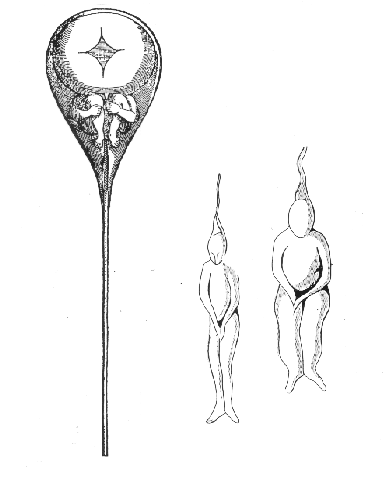Tiny People in Your Semen: The Discovery of Sperm

We take for granted the simplicity of procreation. Sperm + egg = baby. Sure there are superfluous operations often wedged within the greater formula, generally including + alcohol, – inhibition, or / legs (and in my case so many nights spent as the remainder), but there are three sex laws we have always been certain of, right? 1) Spermatozoon hunts for ovum, 2) ovum receives spermatozoon, and 3) sex leans toward brevity, both in the bedroom and in the dictionary (before shortening further to “sperm,” “spermatozoon” had seven additional syllables and drove a NYC taxi).
But math isn’t so simple. Consider this: the number zero wasn’t always a thing. Think about that. There was a time when an adolescent me, charged with the question “so how many girls have you kissed?” would have been morally justified to simply shrug my shoulders and let implication lie for me. But those damn Babylonians had to invent the zero, making it impossible to ethically skirt not only pre-teen sex surveys (the unwritten entrance exam to so many cliques) but also slightly more important questions like “so how many sperms do you see?”
“Zero” would no longer be an acceptable answer after Dutch amateur lensmaker and lonely guy Antonie van Leeuwenhoek combined his microscope-making hobby with his other hobby in 1677 to magnify some human ejaculate. Microscope + semen + zero = sperm!
Though technically sperm was certainly discovered much earlier than 1677–I assume around the first time a human twelve year old male accessed late night basic cable cave drawings–as a scientific discovery Leeuwenhoek is given rightful credit.
I cannot claim to share Leeuwenhoek’s curiosity nor can I match his ambition. As a youth I focused most of my energy playing video games and not knowing how microscopes worked. I was convinced for a full summer, however, that I invented sliced bread. It was the greatest thing since regular bread.
Before Leeuwenhoek disappointed his parents by becoming the sperm guy, he was a professional clothing salesman. One can assume that his decision to root around in human semen came as a direct response to his mother’s constant nagging to “do something more with your life.” Eventually he did do more, taking on a lucrative position as the chamberlain for the Delft sheriffs’ assembly chamber in addition to surveyor by the Court of Holland and later becoming the city’s “wine-guager.” All fairly impressive and noble sounding, but you, much like I, have no idea what those things are. We do however know what sperm is. Sorry Antonie’s mom.
Animal dissection, from the Latin phrase meaning developmental red flag.
The scientific community wasn’t new to the idea of specialized sex cells, though they would not have been learned enough to term them “sex cells.” Keep in mind that “scientific” in the context of 1600s scientific endeavor is a grandiose association; Leeuwenhoek’s peers included a morbid group of three bored guys–Melchisedec Thévenot, Dane Niels Stenson, and Jan Swammerdam–who twelve years prior the discovery of sperm took to cutting up animal uteruses for no better reason than the “cold of recent months.” Sure, that’s one way to get close to sex organs on the ruse of keeping warm. Most people just snuggle, but whatever.
These romantic dissection trysts would ultimately lead Stenson and Swammerdam to conclude that humans come from eggs. This, I understand, happened several years later during hot summer nights spent fondling monkey grundle.
Swammerdam would also eventually see red blood cells and document the first cell divisions in a fertilized frog egg. But remember, people in Leeuwenhoek’s time were “scientific” so frog eggs just weren’t creepy enough.
Enter the weirdest wingman ever, Henry Oldenburg, an early publisher of Leeuwenhoek’s letters, who in 1674 suggested that his friend try slathering some splooge on a microscope slide. And much like an emotionally defeated friend in need of a wingman Leeuwenhoek gave it a shot.
Sperm is people! Tiny, tiny people.
Encouraged by, but not totally honoring, his creepy wingman Leeuwenhoek spent the years following 1674 studying non-semeny water, in which he discovered tiny ‘animalcules’ (a mashup of little and animal). It wasn’t until 1677 when a young medical student named Johann Ham offered a mixture of pus and semen to examine that Leeuwenhoek bit the bullet and dove into “dirtier” water. Perhaps the dilution caused by pus made for a more scientifically respectable sample, thus hedging against accusations of mental absurdity: “no, it’s cool guys, there’s pus in there, too.”
How did the pus find its way into the semen? Ham claimed that the sample had come from a “friend” who had “lain with an unclean woman.” One would hope this encounter not to be the precursor to the Reese’s 1980’s You Got Chocolate in my Peanut Butter campaign, but then again chocolate and peanut butter probably sounded like a disgusting mixture before somebody tried it. Maybe PusCum Nuggets could have been the next peanut butter cup.
To Leeuwenhoek’s surprise, he found little animals swimming in the semen too, as he did in the water. Nothing is said about the probable contamination of the sample; modern minds would think unclean woman pus to have contributed at least a portion of the unfamiliar unicellular activity. As we will learn later though, in Leeuwenhoek’s time women weren’t thought to contribute much in the world of sex and procreation.
Soon after testing his friend’s friend’s semen, in perhaps his first act of actual science, Leeuwenhoek increased the sample size…er, the sample set by confirming the observations using his own semen. Though he had at this point already sifted through vagina pus and stranger cum Leeuwenhoek, in his letter to the Royal Society announcing his discovery, is strangely insistent that he didn’t jerk off: “What I investigate is only what, without sinfully defiling myself, remains as a residue after conjugal coitus.” Conjugal coitus that I assumed ended thusly:
Human extraction vessel: that was wonderful. (reaches for clothes)
Leeuwenhoek: wait. I need that.
Human extraction vessel: need what?
Leeuwenhoek: the…um… the… what’s that? (points out widow)
Human extraction vessel: (follows point) what’s what? (turns back)
Leeuwenhoek: (pocketing a moistened tissue). Never mind. I’m off to the lab.
Human extraction vessel: can we at least snuggle?
Leeuwenhoek: you mean dissect some animal junk? But it’s not even cold outside.
Human extraction vessel: Fine, leave. I’ll just go hang out with Johann Ham and his friend again.
While Leeunwenhoek was able to confirm the existence of the same little animals found inside water and other body fluids, the denser part of the semen interested him more, where he claimed to see networks of nerves, arteries, and veins. “Indeed, I have seen so many of these vessels that I believe I have observed more in a single drop of semen than an anatomist encounters during a whole day of dissection.” Leeunwenhoek believed that semen contained all of the human parts that a person needs to be a person, only smaller.
But how do those tiny people grow? Well, they eat women, of course…

Women are Semen Food
According to Leeuwenhoek, in a letter published in January 1679, “it is exclusively the male semen that forms the foetus” while woman simply “receive the semen and feed it”. In Leeuwenhoek’s defense, he is not forcing a domestic role on women in a this-is-your-husband’s-belly,-feed-it kind of way. Rather, imagine that her husband’s belly is a zombie and the mother just a brain (but that metaphor breaks down immediately, because nobody in Leeuwenhoek’s time would have associated woman with brain).
Leeuwenhoek’s assumption wasn’t new. In fact, for centuries beginning in ancient greek with Pythagoras and later with Aristotle, woman, in terms of procreation, were basically pig troughs. According to Aristotle “what the male contributes to generation is the form and the efficient cause, while the female contributes the matter.”
Leeuwenhoek, in his typical 1670s scientist-cum-guy-who-pokes-things-with-a-stick mentality, discounted the human eggs as mere “globules” and in turn compared them to horse urine: “And…we see that fat, pus, and certain parts of a horse’s urine also consist of globules.”
Curiously, Leeuwenhoek’s frame of reference seems to be dominated by pus. Between an earlier experiment’s ‘hard pus’ found in healthy sheep lungs and the aforementioned egg-pus comparison and semen-pus mixture, I’m beginning to think that in Leeuwenhoek’s time either 1) pus, like sexism, was a ubiquitous certainty or 2) pus represented an acceptable neutral response amid laboratory befuddlement.
Scientist 2: (shrugs) Pus
Scientist 1: Good one. What do you think the stars are made of?
Scientist 2: (shrugs) Pus
Scientist 1: You’re a riot, Scientist 2. Want to share my lunch?
Scientist 2: What did you bring?
Scientist 1: Pus…just kidding. It’s a semen sandwich.
A Catholic Priest has Valid Ideas about Sex
It wasn’t until almost 100 years later in 1768 that Lazzaro Spallanzani, an Italian Catholic priest, biologist and physiologist discovered that sperm + egg = screaming poop generator. By this time the idea that sperm contains literal tiny people was laughable. At least I hope the idea was no longer taken seriously. Otherwise, given the new pedestal upon which the sperm sat, continuing to relegate the egg as mere semen food seems unfair in a biological glass ceiling kind of way.
If you liked this article, please share it. Please! It would mean the world to me.
Why not help me out? Tweet using one of these pre-composed tweets by simply clicking a tweet below.
How was sperm discovered? Well, with a microscope, yes, but how else? @calebjross tells you here http://cjrlit.com/1tXZNQn
Laugh and learn as @calebjross tells you about the discovery of sperm here http://cjrlit.com/1tXZNQn
Why did people thing sperm was tiny people? @calebjross tells you about the discovery of sperm here http://cjrlit.com/1tXZNQn

